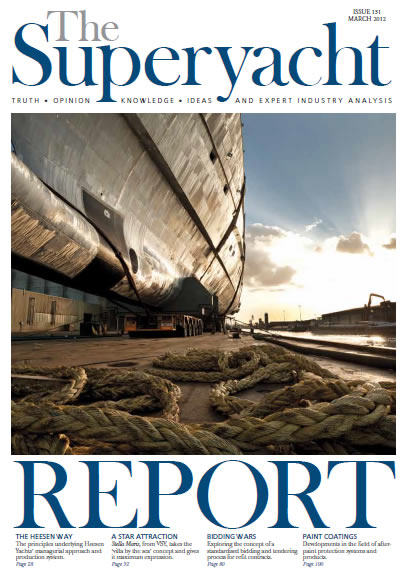
The Superyacht Report 131-After paint treatments
Newmar Overseas Ltd
Scientific study on paint dur ability is one thing; however, the key to understanding the expected duration of the cosmetic finish of the surface coating lies with type/ build of the vessel and how it will be used during its life.
A private family yacht that is used to enjoy a few weeks during summer months experiences a very different use and maintenance regime from a charter vessel that will see many months of use through the both summer in the Mediterranean, and winter season in the Caribbean. This is reflected in the fact that some vessels require recoating in three- or four-year cycles, whilst others are rarely repainted. This, however, is not to say that the cosmetic finish expected is different.
In fact, quite the opposite; with very few exclusions, yachts are expected to be perfectly finished in all situations and at all times. Current coating systems attempt to accommodate the different requirements of modern yachts with a small range of alternatives from hard-wearing topcoats to softer topcoat options that allow easier and more flexible maintenance strategy. Herein lies the heart of the problem: currently, harder, more resistant coatings do not last well after polishing due to their composition, whilst the longterm performance of softer products is unaffected by polishing. However, as they are 'softer' they are less resistant to wear.
Those involved with the application of coatings and their maintenance are acutely aware of this predicament, and it is precisely for this reason that alternatives are sought from 'after application' coatings that provide a protective layer over paint.
"With very few exclusions, yachts are expected to be perfectly finished in all situations and at all times."
Development and use of these products is at an early stage today and although use is growing it tends to be considered a semi-repaint option allowing the visual appearance to be improved extending the period to the eventual repaint. With development, we should look forward to a time where the use of this type of product could become integrated with an initial paint specification, allowing the combination of improved durability of the overall system through easy reapplication of a surface 'skin'.
Rupert Savage
Managing Director
Rolling Stock SLk
Today, paints are much more susceptible to damage from sun creams, acids used to brighten/clean decks, products used to polish stainless steel and remove rust streaks, exhaust damage and general wear and tear.
There are important considerations to factor in, such as where the vessel is being used, if the vessel is constantly in use, and how many miles a year the vessel travels. Based on these considerations and the expectations of the owner, a paint system can be expected to last anywhere between three and five years. Many paint protection systems have been introduced to the market in recent years – polymers, ceramics, diamonding, nanotechnology, etc.
"There is no 'miracle product' that will replace the necessity to repaint – these products, if selected and applied correctly, are simply there to extend the life of the paint."
These products can be used with newly applied paint – to protect and prolong the finish or to revive weathered paint. Both have pros and cons. I believe there is certainly a place in the market for both applications, but it is important to consider the following:
- Choice of product – there are many products on the market that claim to be the best. Do your market research and seek references;
- Choice of application company – these products are best applied by profession applicators. However, even the best product, applied badly, can have devastating effects on the paint system;
- There is no 'miracle product' that will replace the necessity to repaint – these products, if selected and applied correctly, are simply there to extend the life of the paint.
Remy Millott
CEO
PINMAR
For a vessel being used in normal conditions and coated in a non-metallic polyurethane system, the topcoat should last between three and four years. Many vessels will repaint every third year, although in the current climate we have seen this being extended to four or five years.
The development of protective polymer, ceramic and similar coatings systems has meant that topcoats can look better for longer periods. Many of the protection systems require abrasive treatment of the existing coatings to remove oxidation, ingrained dirt and contamination, which reduce the topcoat layers. The concept is then to apply products to rejuvenate the topcoat and leave a protective layer of a few microns on the surface. The protective coatings are not generally as strong or effective as a new paint layer, so the idea is to treat the process as a shortterm solution, which can be very effective depending on the type of product and the experience of the applicators. Before these modern products were developed, people used car waxes modified for the marine environment, but they are less effective and wash away easily, meaning the surfaces return quickly back to their deteriorated state, but severely damaged through the polishing process.
If treated correctly, using the right nondamaging products, the life of new paint work can be extended and tired paint work can be rejuvenated, but always with the understanding that these products are not a long-term alternative to painting a vessel, as this could lead to other more serious problems.
Joop Ellenbroek
Managing Director
CCS Yacht Coating Services
Freshly applied topcoats used to be sacred, not to be touched or treated. The traditional polyurethane topcoat preferred 'to be left alone', to be repainted when the paint 'got tired'. Repainting a yacht is an expensive and time-consuming matter and many owners and captains wonder why such an expensive job with expensive top quality products has to be repeated after a relatively short time (two to four years). This situation turned out to be an 'open door' for products that allegedly provided additional properties to the topcoat, like improved gloss retention and easier cleaning properties.
"A growing use of successful 'life-extension materials' is a potential threat to the paint suppliers and refit yards..."
Many products are being offered based on various old and new technologies. This creates a confusing situation for captains and owners who have questions, such as: Does the product affect the integrity of the topcoat? Are there any repercussions for the repainting process – technically or financially? How often do I have to repeat the treatment? After every three months? After every six months? A short poll under a few captains showed us that there are mixed experiences, ranging from successfully extending the performance life to a forthright rejection because of disappointing results. So far, the paint suppliers have been quite passive regarding the phenomenon of topcoat protection materials – 'it's not their product'. However, a growing use of successful 'life-extension materials' is a potential threat to the paint suppliers and refit yards: imagine that yachts could require repainting after six years instead of four years. The recent introduction of a topcoat protection material by a repainting contractor is interesting in the light of the above. Maybe these developments could work as a catalyst for the paint suppliers to investigate the possibility to develop topcoats where these special properties have been incorporated into the formulation? Indeed, the time may be right for a new generation of topcoats!
Joop Ellenbroek
Managing Director
CCS Yacht Coating Services
Freshly applied topcoats used to be sacred, not to be touched or treated. The traditional polyurethane topcoat preferred 'to be left alone', to be repainted when the paint 'got tired'. Repainting a yacht is an expensive and time-consuming matter and many owners and captains wonder why such an expensive job with expensive top quality products has to be repeated after a relatively short time (two to four years). This situation turned out to be an 'open door' for products that allegedly provided additional properties to the topcoat, like improved gloss retention and easier cleaning properties.
"A growing use of successful 'life-extension materials' is a potential threat to the paint suppliers and refit yards..."
Many products are being offered based on various old and new technologies. This creates a confusing situation for captains and owners who have questions, such as: Does the product affect the integrity of the topcoat? Are there any repercussions for the repainting process – technically or financially? How often do I have to repeat the treatment? After every three months? After every six months? A short poll under a few captains showed us that there are mixed experiences, ranging from successfully extending the performance life to a forthright rejection because of disappointing results. So far, the paint suppliers have been quite passive regarding the phenomenon of topcoat protection materials – 'it's not their product'. However, a growing use of successful 'life-extension materials' is a potential threat to the paint suppliers and refit yards: imagine that yachts could require repainting after six years instead of four years. The recent introduction of a topcoat protection material by a repainting contractor is interesting in the light of the above. Maybe these developments could work as a catalyst for the paint suppliers to investigate the possibility to develop topcoats where these special properties have been incorporated into the formulation? Indeed, the time may be right for a new generation of topcoats!
Philip Dempler
Owner's representative
Demler Marine Projects GmbH
Of course, a paint job does not turn bad at one point, it gradually degrades and it depends on the owner and his team at what point they decide it's no longer acceptable. For a paint job to be superyacht standard, this timeframe should be around five years. Whether the new paint protection systems actually lengthen the time span of the paint, I can't say. They do, however, facilitate maintenance and make cleaning faster and easier. We have used the Shineyachts treatment on a composite boat with a dark hull, and it has substantially reduced the amount of time and labour that is needed to keep the hull looking good. Especially after long periods of sailing; the salt is easier to wash off than before the treatment. This has to be reapplied each year, but our experience with this system is very good.
Chris Atkinson
Director
ACA Marine
In general, we believe a paint job done by ACA should last at least four years. The very highly exposed surfaces such as transom, forward and rear eyebrows will lose gloss faster than the inner bulwarks and casing walls.
However, quite often a few corrosion spots may start within two years in areas where stainless fixings are present. Such areas will need to be dealt with locally to maintain the overall good visual effect. I personally do not like to have a new spray job finish protected immediately after painting, as it can often cause warranty problems between applicator, paint manufacturer, paint protection companies and the captains if there is a failure during the post repaint warranty period (between one and two years). For me, the ideal time to undertake such techniques is when the paint is starting to look dull and faded. The glazes will re-boost the shine for another six to 12 months.
Kay Wrede
Managing director
Wrede Consulting
The corrosion protection of a yacht could last 10 to 20 years, in exceptional cases, even up to 30 years. This assumes that the build-up is correct, thus the substrate preparation, the individual layers and the choice of materials should have been tailored to the ship. For example, steel vessels that are a primer for corrosion protection, the filler with a two-layer epoxy sealant and the UV-stable finish, thus the paint. It is UV protection and cosmetic at the same time.
The durability of the coating depends in one part on the preparation of the coated hull and, on the other hand, on the effects from outside factors. This could be, for example, heat and cold, or UV radiation and the operation area of the yacht. In the Caribbean, a new coating could be necessary after four years. The more the paint is protected, the better. Solvents, stains and hard brushes reduce its lifetime additionally.
After-paint protection primarily helps against abrasion due to aging. The plasticisers are lost gradually and the coating loses its elasticity. UV radiation breaks open the molecular structure of the cosmetic layer, thus the paint. Here, surface seals come into play: the best experiences we have had are with polishes containing carnauba wax. It is water and dirt repellent and protects between three and six months, depending on the operation area. In the Caribbean it can lose its protection in just weeks. When waxing, the application is a crucial point. Liquid solvent-based waxes result in a very good surface, but less protection; wax polishes have better protection, but are difficult to apply cloud-free. Especially on large areas and dark colours, this is a problem for the crew.
New coatings should not be polished before sealing, older coatings need a very fine polish. With long demurrage, it may be advisable to cover the ship.
AFTER-PAINT TREATMENTS: WHAT'S ON THE MARKET
SEA-SHIELD Nano Coating – SEA-SHIELD Exhaust Guard
This nano coating is made of a blend of a nano cross-linking polymers.
It contains a high concentration of UV inhibitors and the cross-linking polymers form a covalent bond producing a coating that is UV and water resistant. To make sure the same surface is protected against black streaks and exhaust residue, Sea-Shield Exhaust Guard, which contains acrylic resins, is applied to the surface after the Sea-Shield Nano Coating has cured for at least eight to 12 hours. The coating is not permanent and lasts an average of six months and, in most instances, can be reapplied when needed.
Complete article in :



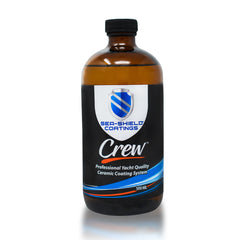 Crew Ceramic Coating
Crew Ceramic Coating
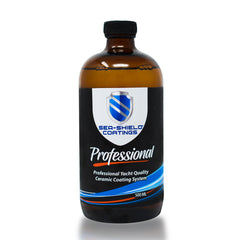 Professional Ceramic Coating
Professional Ceramic Coating
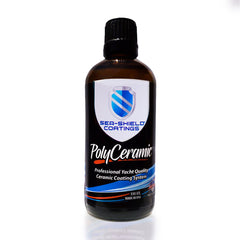 Polyceramic Coating
Polyceramic Coating
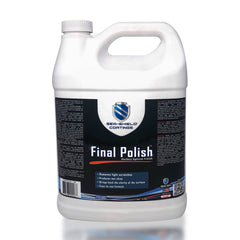 Polishes
Polishes
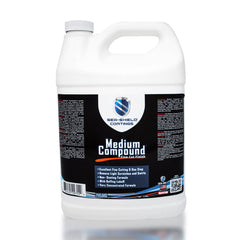 Compounds
Compounds
